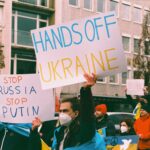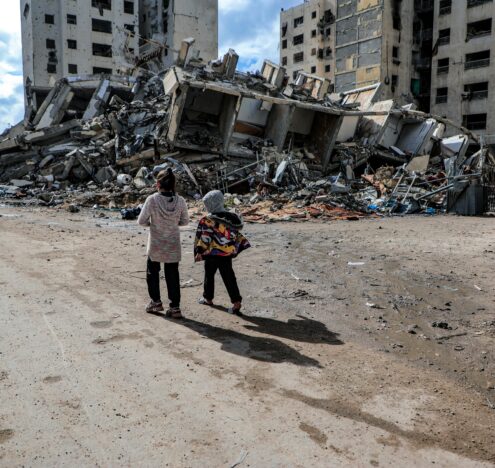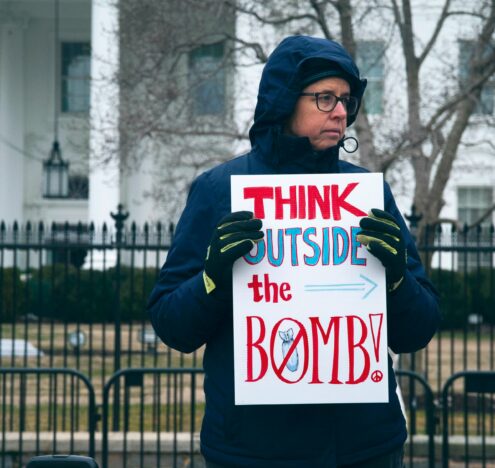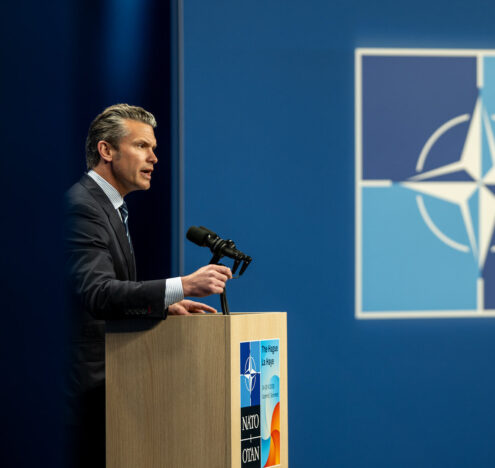Russia’s nuclear saber-rattling in the Russia-Ukraine War is growing louder. With Ukraine recovering areas seized by Russia earlier in the conflict, President Vladimir Putin is issuing stark warnings that Russia may use nuclear weapons to maintain control of territory it now claims as its own. Much remains unclear about Russia’s posturing, including how Russia might use nuclear forces and, most critically, whether Putin is bluffing. But, as far as the United States is concerned, one thing is clear: Should Russia make good on its nuclear threats, many in Washington now advocate a conventional attack on Russian forces in theatre, from the Black Sea fleet to targets in Ukraine and perhaps Russia itself.
David Petraeus, for instance, advocates a NATO effort “that would take out every Russian conventional force that we can see and identify on the battlefield in Ukraine and also in Crimea and every ship in the Black Sea.” Similarly, the Atlantic Council’s Matthew Kroenig advises “a limited conventional strike against the Russian forces or bases that launched the nuclear attack.” Former NATO Deputy Secretary General Rose Gottemoeller expects a “strong non-nuclear” military response should Russia go nuclear, just as the former commander of US army forces in Europe Ben Hodges calls for “destroying the Russian Black Sea Fleet or Russian bases in occupied Crimea.”
These calls may seem reasonable, even circumspect, given that Russia will have let the nuclear genie out of the bottle. However, proponents of a strike are burying the lede. Make no mistake: What Petraeus, Kroenig, and others advocate is nothing less than a decision that would precipitously raise the risk of an all-out war between the United States, NATO, and Russia. After all, a conventional attack would invite a Russian response; the United States and its allies would likely feel compelled to respond yet again; and so on. This is a recipe for a great power war, the likes of which we haven’t seen since the World Wars. All the more dangerous — and unlike the world wars — a direct US-Russia war could escalate further into an all-out strategic nuclear exchange that might well see the United States (and the world as we know it) destroyed.
EXTREME CONTRADICTIONS
Despite calling for the United States to bear such stark risks, proponents have yet to make a compelling argument as to why Putin’s use of nuclear weapons turns the Ukraine war from its current — a cause worth a proxy war with some limited risk — into a cause worth a significantly elevated risk of a far worse outcome. Indeed, the case being offered for a conventional response is contradictory in the extreme.
First, consider the manifest security dangers ostensibly embedded in Russian nuclear use that merit an American counter-attack. As Kroenig puts it, a Russian strike could cause a lead to Ukraine’s surrender and “break a nearly eight-decade taboo on nuclear use,” “make future nuclear use more likely,” all the while encouraging nuclear proliferation. On the other hand, we are told by proponents that the use of a nuclear weapon would be futile, atrocious, and self-defeating, turning Russia into an international pariah that would be ostracized by almost all members of the international system.
Responding to a nuclear attack against a non-vital interest such as Ukraine will require a creative mix of prudence and punishment.
The problems with these claims are simple. If nuclear use makes Russia a pariah, to the point where it repels even its international partners and neutral states (e.g., China and India), and gains Moscow, at best, a pyrrhic victory on the battlefield, then nuclear use is anything but an encouraging precedent for other aggressors. A US military response would then be superfluous. Of course, other leaders could be unhinged. If so, a counter-attack in support of upholding taboos, sending signals to would-be aggressors and proliferators, and discouraging a dangerous future is irrelevant. After all, unhinged actors are unlikely to pay attention or bank on past US actions. By proponents’ own arguments, in other words, punishment is either already built-in to any Russian nuclear use regardless of what the United States does in response or unlikely to influence others’ behavior.
Of course, nuclear use could be calamitous in other ways, not least through radiation fallout and an unprecedented kind of humanitarian crisis. But if that is the fear, ramping up the prospect of a further nuclear use, or even an exchange, is an unwise response.
Nor is it the case that passivity invites a follow-on Russian attack against the United States or its NATO allies. After all, that Russia can use a nuke against a non-nuclear state such as Ukraine does not establish that it can launch attacks against NATO — an alliance anchored by an Article V commitment and the promise by the United States to use its nuclear assets to retaliate in kind against an attack. Further afield, the same applies to the prospect of other adversaries freely attacking US treaty allies in Asia or beyond. Ultimately, the promise of mutual assistance in wartime is why the United States has alliances and why it includes some states as allies and not others.
In the final analysis, many observers fear the creation of a precedent with calamitous consequences should Russia go nuclear in Ukraine. Far from normalizing the ability of nuclear-armed states to attack their non-nuclear brethren while keeping the world at bay, let’s be clear about what Russia’s precedent would actually entail. A large state tries to take a neighboring state’s capital and overthrow its government. It fails miserably. Western aims, aid, intelligence, and sanctions help. It then tries to fight a more focused campaign along a belt of territory and suffers reversals and losses it could not have imagined, including some of its most reputed military units. Finally, it orders a partial mobilization, calling up barely-trained and raw civilian conscripts. In all this, it becomes a vassal of Beijing, a much larger, richer state next door. It then goes for broke, annexes territory, and issues nuclear threats. In this last part, it may succeed. This is barbaric. But it is also exorbitantly expensive and self-defeating. With one botched military campaign, Russia turns itself from a reputed major power into a large version of North Korea with no immediate way out. Many of the world’s predatory regimes, looking on, are poised to recognize this as an unattractive precedent; alternatively, they may be so distant from reality that they’ll interpret just about anything as encouragement. In no case, however, is an American counter-attack a solution.
In the end, the United States will only face unpalatable choices should Russia go nuclear. It can either go the mats, putting everything on the line just in case third parties misinterpret Putin’s disastrous, futile war followed by nuclear brinkmanship as encouragement. Or, it can forgo a military response and accept some risk that some members of the audience will form the foolish notion that there is a green light for general aggression. This is not zero, and all things must be considered. On balance, though, significantly risking a major war over a limited interest for fear of possible futures would be unwise in the extreme. If, as Otto von Bismarck reportedly said, preventive war is suicide for fear of death, the United States would be risking suicide for fear of uncertainty.
THE MOST IMPORTANT QUESTION
What, then, is to be done should Russia go nuclear in Ukraine? Responding to a nuclear attack against a non-vital interest such as Ukraine will require a creative mix of prudence and punishment. On the punishment side, draconian sanctions — alongside an orchestrated effort to both bring in fence-sitters such as China and India and eliminate loopholes for states such as Hungary — on Russia make sense. Likewise, ensuring Ukraine remains armed to repel further attacks on the territory it has liberated would be natural; accelerating arms supplies would be reasonable. Above all, NATO should tear up the NATO-Russia Founding Act, make preparations for permanently stationed forces in its Central and Eastern European members, ad consider stationing nuclear assets along NATO’s eastern flank. As for prudence, these steps should be coupled with a reaffirmation that the United States is resolved to defend its allies and will use overwhelming force in retaliation for any attacks on its partners.
As Washington contemplates the next steps in the shadow of Putin’s brinkmanship, leaders should be clearer about what’s at stake for them. Now is the time to openly discuss whether taking the steps up the ladder toward nuclear war — or war in a nuclear shadow — is proportionate to the interests at stake. They owe their citizens nothing less.
Patrick Porter is an adjunct scholar with the Cato Institute’s Defense and Foreign Policy Studies department and Professor of International Security and Strategy at the University of Birmingham.
Joshua Shifrinson is an Associate Professor at the University of Maryland’s School of Public Policy, senior fellow with the Center for International and Security Studies at Maryland, and a senior non-resident fellow with the Cato Institute.




















